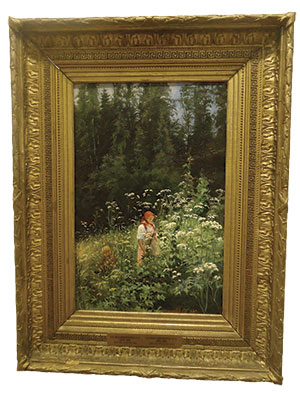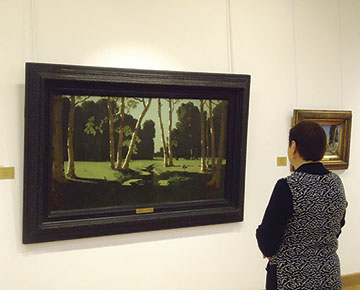
Works by world famous painters from Tretyakov Gallery fit in harmoniously at National Art Museum of Belarus
The exhibition in Minsk showcases Russian painting from the second half of the 19th century and early 20th century, from the Tretyakov Gallery. However, it is the first time that these works have been exhibited.
Pavel Tretyakov wrote to landscape painter Apollinary Goravsky, in the 1860s: ‘I need not grand landscapes, nor a magnificent composition, nor spectacular lighting, nor miracles. Give me a dirty puddle and it will be filled with truth and poetry, as can be found everywhere’.
These words expressed not only Tretyakov’s opinion, but that of the realism movement, which dominated Russian art in the second half of the 19th century. Realism provided an individual perception of nature, as reflected in the creativity of many landscape painters, who strived to portray their world objectively.
The lyrical landscapes by Alexey Savrasov, who was the brightest representative of the Moscow art school, are found side by side with those of Ivan Shishkin, from St. Petersburg. Savrasov’s early landscapes had deep emotional intensity, while his more mature works expressed consonance with the human soul (Landscape with a Marsh and Forest Island, from the late 1860s and early 1870s). Savrasov’s pupil, Isaak Levitan, followed in his footsteps; his works are also on display in Minsk.
Shishkin, meanwhile, showed great objectivity, painting in the open air, and portraying the complexities of the natural environment: the air, sun and light (such as we see in A Summer Day landscape, 1891).
Shishkin’s student, Fiodor Vasiliev, skilfully combined ‘thoroughness of execution without dryness’, bringing vivid emotions to his landscapes, embodying the spirit of those French artists who championed harmony between nature, air and light (later called plein air painting). His delicate and convincing style is apparent particularly in Road Through a Birch Forest. Sadly, Fiodor passed away at a young age.

Near Kuindzhi’s Birch Grove
Plein air landscapes became popular among young Russian artists in the 1870s and 1880s. The head of the Peredvizhniki (The Itinerants), I. Kramskoy, gave the following advice to the young generation, saying that Russian art needed ‘to move towards air, light, and colour’. His notion became popular with many artists.
Arkhip Kuindzhi is considered to be one of the brightest and most unusual artists in the Russian landscape school, giving a realistic perception of the world, combining romanticism with his own brand of creative individuality. His first pictures were associated with the traditions of the Itinerants but later moved towards new means of expression.
Kuindzhi’s Birch Grove was exhibited for the first time at the Association of Itinerants exhibition, in 1879; it set a new trend, depicting the sun, light and shadow. In its dazzling beauty, the Birch Grove brings together symbolic meanings and reality. Ilya Repin called him ‘the painter of the world’ and said, “The illusion of light was his God. No artist was his equal in achieving this miracle of painting.”
Kuindzhi’s contemporaries compared his style and skill with that of Claude Monet and the first French impressionists. He was the first Russian impressionist to paint in this way, recreating the ‘fluorescence’ of nature on canvas.
The early 1870s saw French impressionists influencing Russian painters, shaping their individual style. Artist Vasily Polenov was one of the Russian painters who familiarised students at the Moscow School of Painting, Sculpture and Architecture with the works of French artists in the new style. He began to harmoniously combine traditional landscapes with elements of the new genre, setting the scene for what would become the new ‘norm’ for the next generation of artists, many of whom were his pupils.
This new stage in landscape painting was associated with the name of Isaak Levitan: a pupil of Savrasov and Polenov. He adapted what he had learnt, creating a new style of landscape painting, incorporating spirituality elements from the 19th century and diverse emotional states, as well as artistic skill.

Work by Ferdynand Ruszczyc
| 
|
Konstantin Korovin was the brightest representative of the Russian impressionistic style, preserving freshness, to convey a sense of joy, and a feast of colour. His works delight both the eyes and the soul. Korovin was striving to ‘merge with nature and dissolve in it’. To achieve this, he used free, wide brush strokes and plenty of light in his landscapes, still life works and portraits.
Igor Grabar belonged to the most radical Russian impressionists, using a new means of expression among his peers: separate strokes and a combination of additional colours. He avoided large colour patches and clear contours, working to combine tones, to create an authentic feel.
Stanislav Zhukovsky and Sergey Vinogradov (who have Belarusian roots) had a painting style which we may call Russian lyrical impressionism, having a manner both calm and impressionistic. Their landscapes feature old cottages, forest lakes and quiet rivers, creating an atmosphere of elegiac nostalgia, and the sadness brought by the arrival of autumn.
In the compositions of Konstantin Yuon, there is both immediacy and festive solemnity. Striving for monumentality, he used large-sized canvases, with generalised silhouettes. He emphasised reality, in a new style, which came to be developed by the next generation of artists.
Almost all painters from the late 19th and early 20th centuries used impressionistic elements but Russian impressionism had its own flavour. Unlike the French artists, the Russians did not ‘dissolve’ their subject in light and air, but preserved its tangibility in a free artistic manner. Lyricism had been traditional in Russian landscapes since Savrasov’s times and impressionist inspiration, from the 1880s-1900s, continued until the end of the 20th century.
By Veniamin Mikheev











